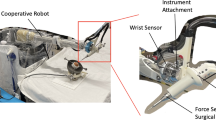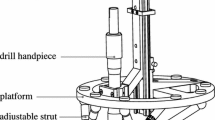Abstract
Purpose
Assistance of robotic systems in the operating room promises higher accuracy and, hence, demanding surgical interventions become realisable (e.g. the direct cochlear access). Additionally, an intuitive user interface is crucial for the use of robots in surgery. Torque sensors in the joints can be employed for intuitive interaction concepts. Regarding the accuracy, they lead to a lower structural stiffness and, thus, to an additional error source. The aim of this contribution is to examine, if an accuracy needed for demanding interventions can be achieved by such a system or not.
Methods
Feasible accuracy results of the robot-assisted process depend on each work-flow step. This work focuses on the determination of the tool coordinate frame. A method for drill axis definition is implemented and analysed. Furthermore, a concept of admittance feed control is developed. This allows the user to control feeding along the planned path by applying a force to the robots structure. The accuracy is researched by drilling experiments with a PMMA phantom and artificial bone blocks.
Results
The described drill axis estimation process results in a high angular repeatability (\(0.026^\circ \,\pm \,16^\circ \)). In the first set of drilling results, an accuracy of \((50\,\pm \,20\,\upmu {\mathrm {m}})\) at entrance and \((170\,\pm \,50\,\upmu {\mathrm {m}})\) at target point excluding imaging was achieved. With admittance feed control an accuracy of \((250\,\pm \,90\,\upmu {\mathrm {m}})\) at target point was realised. In a third set twelve holes were drilled in artificial temporal bone phantoms including imaging. In this set-up an error of \((20\,\pm \,15\,\upmu {\mathrm {m}})\) and \((165\,\pm \,80\,\upmu {\mathrm {m}})\) was achieved.
Conclusion
The results of conducted experiments show that accuracy requirements for demanding procedures such as the direct cochlear access can be fulfilled with compliant systems. Furthermore, it was shown that with the presented admittance feed control an accuracy of less then \(1\,\mathrm {mm}\) is achievable.









Similar content being viewed by others
References
Majdani O, Rau TS, Baron S, Eilers H, Baier C, Heimann B, Leinung M (2009) A robot-guided minimally invasive approach for cochlear implant surgery: preliminary results of a temporal bone study. Int J Comput Assist Radiol Surg 4(5):475–486
Ortmaier T, Weiss H, Döbele S, Schreiber U (2006) Experiments on robot assisted navigated drilling and milling of bones for pedicle screw placement. The Int J Med Robot Comput Assist Surg 2(4):350–363
Schipper J, Aschendorff A, Arapakis I, Klenzner T, Teszler CB, Ridder GJ, Laszig R (2004) Navigation as a quality management tool in cochlear implant surgery. The J Laryngol Otol 118(10):764–770
Bowyer SA, Davies BL, Rodriguez y Baena F (2014) Active constraints/virtual fixtures: a survey. Robot IEEE Trans 30(1):138–157
Eilers H, Baron S, Ortmaier T, Heimann B, Baier C, Rau TS, Leinung M, Majdani O(2009) Navigated, robot assisted drilling of a minimally invasive cochlear access. In: IEEE international conference on mechatronics (ICM) 2009 p 1–6
Bell B, Stieger C, Gerber N, Arnold A, Nauer C, Hamacher V, Kompis M, Nolte L, Caversaccio Weber S (2012) A self-developed and constructed robot for minimally invasive cochlear implantation. Acta oto-laryngol 132(4):355–360
Bell B, Gerber N, Williamson T, Gavaghan K, Wimmer W, Caversaccio M, Weber S (2013) In vitro accuracy evaluation of image-guided robot system for direct cochlear access. Otol Neurotol 34(7):1284–1290
Bettini A, Marayong P, Lang S, Okamura AM, Hager GD (2004) Vision-assisted control for manipulation using virtual fixtures. Robot IEEE Trans 20(6):953–966
Marayong P, Li M, Okamura AM, Hager GD (2003) Spatial motion constraints: theory and demonstrations for robot guidance using virtual fixtures. In: Proceedings IEEE international conference on robotics and automation, 2003, ICRA’03 , vol. 2, p 1954–1959
Cruces RA, Wahrburg J (2007) Improving robot arm control for safe and robust haptic cooperation in orthopaedic procedures. The Int J Med Robot Comput Assist Surg 3(4):316–322
Pieck S, Gross I, Knappe P, Kuenzler S, Kerschbaumer F, Wahrburg J (2003) A navigated mechatronic system with haptic features to assist in surgical interventions. Comput Aided Surg 8(6):292–299
Ortmaier T, Weiss H, Hagn U, Grebenstein M, Nickl M, Albu-Schäffer A, Ott C, Jörg S, Konietschke R, Le-Tien L, Hirzinger G (2006) A hands-on-robot for accurate placement of pedicle screws. In: Proceedings IEEE international conference on robotics and automation, ICRA, p 4179–4186
Labadie RF, Mitchell J, Balachandran R, Fitzpatrick JM (2009) Customized, rapid-production microstereotactic table for surgical targeting: description of concept and in vitro validation. Int J Comput Assist Radiol Surgery 4(3):273–280
Kobler JP, Nuelle K, Lexow GJ, Rau TS, Majdani O, Kahrs LA, Kotlarski J, Ortmaier T (2016) Configuration optimization and experimental accuracy evaluation of a bone-attached, parallel robot for skull surgery. Int J Comput Assist Radiol Surg 11(3):421–436
Taylor RH, Mittelstadt BD, Paul HA, Hanson W, Kazanzides P, Zuhars JF, Williamson B, Musits BL, Glassman E, Bargar WL (1994) An image-directed robotic system for precise orthopaedic surgery. IEEE Trans Robot Autom 10(3):261–275
Hagn U, Konietschke R, Tobergte A, Nickl M, Jörg S, Kübler B, Passig G, Grger M, Frhlich F, Seibold U, Le-Tien L, Albu-Schffer A, Nothhelfer A, Hacker F, Grebenstein M, Hirzinger G (2010) DLR mirosurge: a versatile system for research in endoscopic telesurgery. Int J Comput Assist Radiol Surg 5(2):183–193
Widmann G, Stoffner R, Bale R (2009) Errors and error management in image-guided craniomaxillofacial surgery. Oral Surg Oral Med Oral Pathol Oral Radiol Endodontol 107(5):701–715
Kobler JP, Díaz JD, Fitzpatrick JM, Lexow GJ, Majdani O, Ortmaier T (2014) Localization accuracy of sphere fiducials in computed tomography images. In: Proceedings on International Society for optics and photonics SPIE 9036 medical imaging
Fuchs A, Tauscher S, Borcherding S, Kahrs LA, Ortmaier T (2015) Robot assisted calibration of an optical localisation system. In: Proceedings of computer assisted radiology and surgery 2015, p 1–16
Kobler JP, Prielozny L, Lexow GJ, Rau TS, Majdani O, Ortmaier T (2015) Mechanical characterization of bone anchors used with a bone-attached, parallel robot for skull surgery. Med Eng Phys 37(5):460–468
Schreiber G, Stemmer A, Bischoff R (2010) The fast research interface for the kuka lightweight robot. In: IEEE workshop on innovative robot control architectures for demanding (research) applications how to modify and enhance commercial controllers (ICRA 2010)
Crause LA, O’Donoghue DE, O’Connor JE, Strümpfer F (2010) Use of a faro arm for optical alignment. In: Proceedings SPIE Astronomical Telescopes+ Instrumentation 7739. International Society for optics and photonics
Gerber N, Gavaghan KA, Bell BJ, Williamson TM, Weisstanner C, Caversaccio MD, Weber S (2013) High-accuracy patient-to-image registration for the facilitation of image-guided robotic microsurgery on the head. IEEE Trans Biomed Eng 60(4):960–968
Fuhrmann AL, Splechtna R, Přikryl J (2001) Comprehensive calibration and registration procedures for augmented reality. In: Immersive projection technology and virtual environments, Springer Vienna, p 219–227
Schönemann PH (1966) A generalized solution of the orthogonal procrustes problem. Psychometrika 31(1):1–10
Albu-Schäffer A, Ott C, Frese U, Hirzinger G (2003) Cartesian impedance control of redundant robots: recent results with the DLR-light-weight-arms. In: Proceedings IEEE international conference on robotics and automation, 2003, ICRA’03, vol. 3, p 3704–3709
Li T, Kermorgant O, Krupa A (2012) Maintaining visibility constraints during tele-echography with ultrasound visual servoing. In: IEEE international conference on robotics and automation (ICRA), 2012, p 4856–4861
Labadie RF, Balachandran R, Noble JH, Blachon GS, Mitchell JE, Reda FA, Dawant BM, Fitzpatrick JM (2014) Minimally invasive image-guided cochlear implantation surgery: first report of clinical implementation. The Laryngo 124(8):1915–1922
Fitzpatrick JM, West JB, Maurer CR Jr (1998) Predicting error in rigid-body point-based registration. Med Imag IEEE Trans 17(5):694–702
Kobler JP, Schoppe M, Lexow GJ, Rau TS, Majdani O, Kahrs LA, Ortmaier T (2014) Temporal bone borehole accuracy for cochlear implantation influenced by drilling strategy: an in vitro study. Int J Comput Assist Radiol Surg 9(6):1033–1043
Feldmann A, Gavaghan K, Stebinger M, Williamson T, Weber S, Zysset P. (2017) Real-Time Prediction of Temperature Elevation During Robotic Bone Drilling Using the Torque Signal. Ann Biomed Eng, 1–10
Tauscher S, Tokuda J, Schreiber G, Neff T, Hata N, Ortmaier T (2015) OpenIGTLink interface for state control and visualisation of a robot for image-guided therapy systems. Int J Computer Assist Radiol Surg 10(3):285–292
Acknowledgements
Responsibility for the contents of this publication lies with the authors.
Author information
Authors and Affiliations
Corresponding author
Ethics declarations
Conflict of interest
Sebastian Tauscher, Alexander Fuchs, Fabian Baier, Lüder Alexander Kahrs, and Tobias Ortmaier declare that they have no conflict of interest.
Ethical statement
This article does not contain any studies with human participants or animals performed by any of the authors.
Informed consent
This article does not contain patient data.
Rights and permissions
About this article
Cite this article
Tauscher, S., Fuchs, A., Baier, F. et al. High-accuracy drilling with an image guided light weight robot: autonomous versus intuitive feed control. Int J CARS 12, 1763–1773 (2017). https://doi.org/10.1007/s11548-017-1638-x
Received:
Accepted:
Published:
Issue Date:
DOI: https://doi.org/10.1007/s11548-017-1638-x




